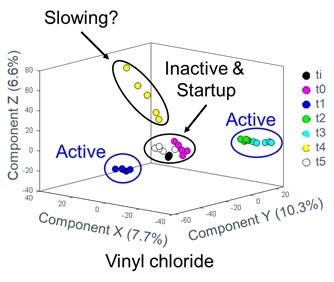Superfund Research Program
June 2021

The team looked at the metabolome of microbial cultures and captured their activity as they degraded the contaminant 1,2-Dichloroethene over time.
(Photo courtesy of Microbial Insights, Inc.)
Researchers at SRP-funded small business Microbial Insights use highly sensitive instruments to analyze metabolites, small molecules that result from different chemical and biological processes. Their goal is to provide key insights on site-specific conditions that affect the ability of bacteria to break down harmful contaminants in the environment.
This knowledge allows the researchers to characterize the biodegradation activity of chlorinated compounds, recognize degradation stalls, and assess microbial community function and health. Their product searches metabolomics data from diverse sites to identify patterns and derive a fingerprint of what a healthy and effective bioremediation system looks like, providing useful information for site managers.
| Technology | Microbial Insights is developing a workflow using data from Ultra High-Performance Liquid Chromatography-Orbitrap Mass Spectrometer to identify metabolic patterns and biomarkers related to the biodegradation activity of chlorinated compounds. |
|---|---|
| Innovation | This analysis service opens new doorways for site characterization and reveals the possibility of a molecular biological tool with predictive capabilities. These measurements relate directly to dechlorination activity and inactivity and may also provide information on the overall health of the microbiome. |
| Contaminant and Media | Chlorinated ethenes are among the most common contaminants impacting Superfund sites. The researchers have performed studies on groundwater samples collected from three different sites contaminated by chlorinated ethenes. Across the sites, metabolite patterns could be used to differentiate between samples collected from background locations, locations where active degradation was taking place, and locations where degradation had stalled. This type of analysis will allow researchers and other stakeholders to implement more efficient strategies and to clean up contaminated sites more quickly and economically compared to existing technologies. |
| Technology Readiness Level | TRL 6 – System adequacy validated in simulated environment |
| Principal Investigator | Dora Taggart |
| Institution | Microbial Insights, Inc. |
| Grant Number | R43ES030669 |


